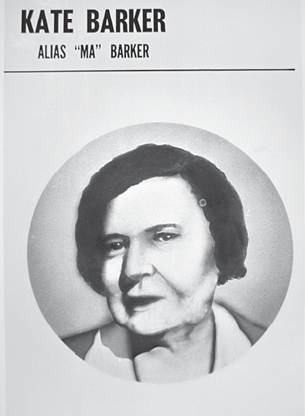Kate “Ma” Barker (1872–1935) was the matriarch of a notorious family of midwestern bank robbers. During the Great Depression, Barker and her sons were accused of dozens of bank heists and murders after leaving a trail of violence from Oklahoma to Chicago. Proclaimed a public enemy, she was the target of a sensational nationwide hunt until the gang was cornered in Florida and gunned down by the FBI.

Born in Missouri, Kate Clark married a man named George Barker in the 1890s. They had four sons—Herman, Lloyd, Arthur (1899–1939), and Fred (1902–1935)—all of whom would grow up to become criminals. For much of the 1910s and ’20s, the Barker sons were in and out of jail for bank robbery, car theft, and other crimes. One of the sons, Herman, committed suicide in 1927.
The family business took a more violent turn after 1931, when Fred Barker teamed up with Alvin “Creepy” Karpis (1907–1979), a convicted thief he had met in prison, to form the Barker-Karpis Gang. The gang embarked on a crime spree that would last for the next four years.
Ma Barker’s role in the gang has long been debated. In press accounts, she was often portrayed as the leader of the gang. During an era of deep public anxiety over crime, Barker joined other famous criminals, such as John Dillinger (1903–1934) and Willie Sutton (1901–1980), as a symbol of the breakdown of law and order during the Depression.
The gang was implicated in the killings of several policemen and the kidnapping for ransom of a Minnesota millionaire. Ma and Fred Barker were eventually traced to a rental house in Florida, where they were killed in a shootout. Barker was sixty-two; she was allegedly cradling a tommy gun when she died. Since then, however, critics have suggested that the FBI may have exaggerated her importance to the gang so the bureau could claim credit for bringing down a major criminal.
ADDITIONAL FACTS
- Another of Barker’s sons, Arthur, was killed while trying to escape from the federal penitentiary at Alcatraz Island. The Barkers’ accomplice, Alvin Karpis, served twenty-six years at the Rock, the longest of any inmate at the infamous prison. He was released in 1969.
- Ma Barker was the inspiration for the Disney comic character Ma Beagle, the head of the Beagle Boys gang, which habitually attempts to steal Scrooge McDuck’s fortune.
- A B movie, Ma Barker’s Killer Brood, was released in 1960. It starred Lurene Tuttle (1907–1986)—who was probably better known for her minor role in Psycho, released in the same year. Academy Award–winning actress Shelley Winters (1920–2006) played Barker in Bloody Mama (1970).
